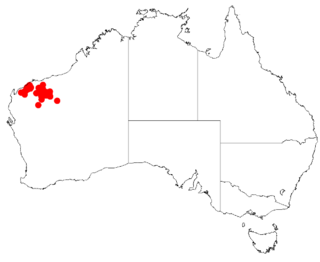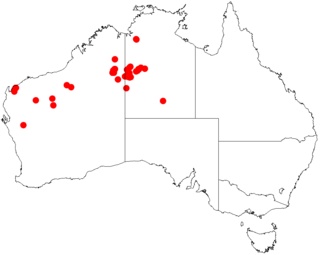
Acacia atkinsiana, commonly known as Atkin's wattle, is a shrub belonging to the genus Acacia and the subgenus Juliflorae endemic to Australia. The indigenous peoples of the area where the shrub is found, the Kurrama peoples, know the shrub as Bilari or Pilarri.

Acacia bromilowiana, commonly known as Bromilow's wattle, is a tree belonging to the genus Acacia and the subgenus Juliflorae that is endemic to a small part of north western Australia.

Acacia elachantha is a shrub belonging to the genus Acacia and the subgenus Juliflorae. It is native to arid parts of central and northern Australia.

Acacia macraneura, commonly known as big mac wattle, is a shrub belonging to the genus Acacia and the subgenus Juliflorae that is native to arid parts of western Australia.

Acacia pachycarpa is a tree or shrub belonging to the genus Acacia and the subgenus Juliflorae that is endemic to central and western parts of northern Australia.

Acacia rhodophloia, commonly known as minni ritchi or western red mulga, is a tree or shrub belonging to the genus Acacia and the subgenus Juliflorae that is endemic to a large area of arid central western Australia. The Indigenous group the Kurrama peoples know the plant as mantaru.

Acacia acanthaster is a shrub belonging to the genus Acacia and the subgenus Phyllodineae. It is native to an area in the Great Southern and Goldfields-Esperance regions of Western Australia.

Acacia ampliceps, also known as salt wattle, is a shrub or tree belonging to the genus Acacia and the subgenus Phyllodineae that is native to north western parts of Australia.

Acacia anthochaera is a shrub or tree belonging to the genus Acacia and the subgenus Phyllodineae native to Western Australia.

Acacia aphanoclada, also known as Nullagine ghost wattle, is a shrub belonging to the genus Acacia and the subgenus Phyllodineae. It is native to a small area in the Pilbara region of Western Australia.

Acacia chartacea is a shrub or tree belonging to the genus Acacia and the subgenus Phyllodineae endemic to an area along the west coast of Western Australia.

Acacia dictyophleba, also known as the sandhill wattle, waxy wattle and feather veined wattle, is a shrub belonging to the genus Acacia and the subgenus Phyllodineae. The Nyangumarta peoples know the plant as Langkur or Lungkun and the Thalanyji know it as Jabandi.

Acacia marramamba, commonly known as marramamba, is a shrub or tree belonging to the genus Acacia and the subgenus Phyllodineae that is endemic to arid parts of western Australia.
Acacia minutissima is a shrub belonging to the genus Acacia and the subgenus Phyllodineae that is endemic to parts of western Australia.

Acacia pachyacra is a tree or shrub belonging to the genus Acacia and the subgenus Phyllodineae. that is endemic to arid parts of central and western Australia.

Acacia robeorum, commonly known as Robe's wattle, is a shrub of the genus Acacia and the subgenus Phyllodineae that is endemic to north western Australia.

Acacia sabulosa is a shrub of the genus Acacia and the subgenus Phyllodineae that is endemic to north western Australia.

Acacia arrecta, commonly known as Yarnda Nyirra wattle or Fortescue wattle, is a shrub of the genus Acacia and the subgenus Plurinerves that is endemic to arid areas in north western Australia.

Acacia sericophylla is a shrub or tree commonly known as the desert dogwood, desert oak or cork-bark wattle. To the Indigenous Australian people of the Pilbara, the Nyangumarta peoples, it is known as Pirrkala. The species is of the genus Acacia and the subgenus Plurinerves.
Acacia exilis, commonly known as muntalkura wattle, is a species of wattle belonging to the genus Acacia and the subgenus Juliflorae. The Kurrama peoples know the tree as jonanyong or jananyung. It is native to an area of the Pilbara region of Western Australia.



















